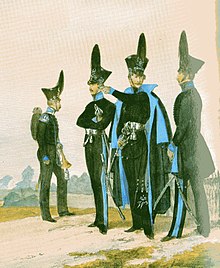Brunswick Body Battalion
The Herzoglich Braunschweigische Leibbataillon was an association of the Braunschweig military and existed from 1815 to 1893.
prehistory
The origin of the body battalion goes back to the black band set up by Duke Friedrich Wilhelm von Braunschweig-Oels in 1809 , who fought against the troops of Napoleon Bonaparte . The Freikorps changed as " Braunschweig-Lüneburgsche Jäger " in English service, fought under Wellington's command in the so-called " Peninsula War " in Portugal and Spain before returning to Braunschweig on November 10, 1814.
Established in 1815
On January 1, 1815, the veterans of the “Peninsula War” were formed into the “ battalion under the orders of Major von Pröstler”. However, since many soldiers had already quit their service at the end of 1814, the companies were replenished by members of the avant-garde battalion established in 1813 . On April 14th it was named "Leibbataillon" . It consisted of four companies and had a nominal strength of 672 men.
The body battalion basically continued to wear the uniform that the Braunschweig-Lüneburg hunters had worn in Spain: a black dolman and the black shako with the white metal skull and black horsehair bush.
Campaign 1815

After Napoleon's return, Duke Friedrich Wilhelm ordered immediate mobilization and on April 15 the Duke Brunswick Field Corps set out for Belgium . The life battalion belonged together with the three light battalions to the light brigade under the command of Lieutenant Colonel Wilhelm Treusch von Buttlar . On May 11th they reached their positions near Brussels .
On June 16, there was the first battle at Quatre-Bras . According to eyewitnesses, the body battalion played an important role in this. Duke Friedrich Wilhelm fell in this battle near the body battalion and was brought behind the lines by three soldiers ( Corporal Külbel , Hornist Aue and Jäger Reckau). The body battalion suffered heavy losses in this battle.
Two days later, on June 18, it took part in the Battle of Waterloo . Here it was used on the right flank near the Hougomont homestead and again earned recognition for its work.
After the battle, the body battalion was tasked with escorting 2,000 French prisoners to Brussels. It then followed the rest of the corps to Paris, from where it marched back to Braunschweig on December 6, 1815.
Development after 1816
After returning from France, the troops of the Duchy of Braunschweig were greatly reduced, only the minimum required by the German Confederation was kept under arms. First four infantry battalions were disbanded, followed by two more in 1822, and the body battalion was retained.
When Charles II took over the government , the Brunswick military was completely changed. The old life battalion became the 1st battalion of the 1st Line Infantry Regiment and a new life battalion (also called Jäger Battalion ) was formed from particularly outstanding soldiers. While all other battalions now received a blue uniform in the Prussian style, the body battalion kept its historic black uniform.
After Charles II was expelled in 1830, Wilhelm took over the government and immediately reduced the size of the army, which had been enlarged by his ostentatious brother. The body battalion took on the soldiers of the dissolved 2nd battalion of the 1st line regiment, but remained an independent unit. It was not until 1867 that it became the "Fusilier Battalion (Leib-Bataillon)" of the Duke Braunschweig Infantry Regiment No. 92 and after the military convention with Prussia it became the 3rd (Leib) Battalion of the same regiment. On October 1, 1893, the life battalion ceased to exist, formed only one company, which was merged into the 5th Hanoverian Infantry Regiment No. 165 in Blankenburg on April 1, 1897 .
literature
- Gustav von Kortzfleisch : History of the Duke Braunschweig Infantry Regiment and its regular troops 1809–1902. 3 volumes, Limbach , Braunschweig 1896–1903, digital copies: Volume 1 , Volume 2 , Volume 3 .
- Georg Ortenburg: Brunswick military. Elm-Verlag, Cremlingen 1987, ISBN 3-980-02196-3 .
- Otto von Pivka : The Black Brunswickers. Osprey Men-at-Arms, Osprey Publishing, Oxford 1973, ISBN 0-850-45146-9 .
- Wilhelm Teichmüller: History of the Duke Braunschweigischen Leibbataillon. Schwetschke , Braunschweig 1858, OCLC 64411657 .
Individual evidence
- ↑ Captain Batty of the Grenadier Guards in a letter dated June 21, 1815. John Booth: The Battle of Waterloo. London 1852. p. 38 and General Halkett, after Kortzfleisch, vol. 2, p. 73
- ↑ see: Ernst Carl Külbel: The last moments of our most noble Duke Friedrich Wilhelm at Quatrebras on June 16, 1815 . 2nd edition, Celle 1865, digitized
- ↑ Captain Batty of the Grenadier Guards in a letter dated June 22, 1815. John Booth The Battle of Waterloo. London 1852. p. 41
Web links
- Interest group of the Herzoglich Braunschweigisches Leibbataillon from 1815 on leibbataillon.de
- The history of the Braunschweig military 1671–2003 ( Memento from February 12, 2005 in the Internet Archive ) on immotafides.de
- Project of the historical seminar of the TU Braunschweig among other things on the black crowd / Friedrich Wilhelm on gibs.info


